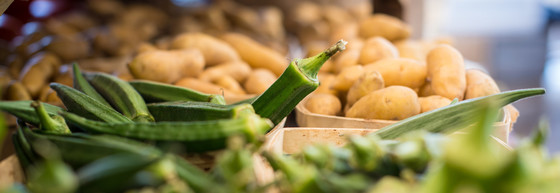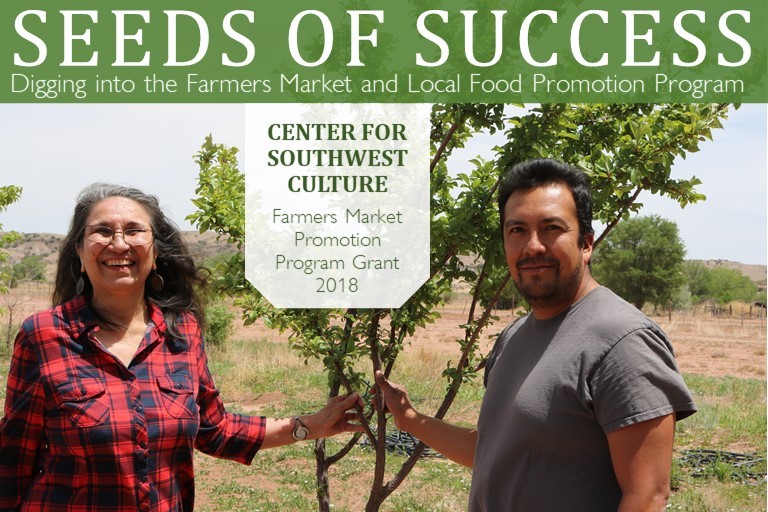|
It’s always a busy time at USDA, and this fall is no different. We’re kicking off this issue with a roundup of grant awards and funding announcements.
 Farm and Food Workers Relief Grant
USDA is accepting applications for the new Farm and Food Workers Relief (FFWR) grant program. The program will provide $665 million to fund competitive grant applications to provide relief to farmworkers and meatpacking workers who incurred pandemic-related health and safety costs. Eligible state agencies, tribal entities and non-profit organizations serving farmworkers and meatpacking workers can apply now through Feb. 8, 2022, at www.grants.gov for grants ranging from $5 million to $50 million.
Pandemic Response and Safety Grant Program – Applications due
November 22
The Pandemic Response and Safety (PRS) Grant Program provides funding to help small specialty crop producers, food processors, manufacturers, distributors and farmers markets recover costs incurred responding to the COVID-19 pandemic, including for measures to protect workers. This program is authorized and funded under the Consolidated Appropriations Act of 2021 (Pub. L. No. 116—260). The minimum funding request amount is $1,500. The maximum funding request amount is $20,000. No cost sharing or matching funds are required. Grants will cover activities associated with:
- Workplace Safety: Implementing workplace safety measures to protect against COVID-19
- Market Pivots: Implementing market pivots to protect against COVID–19
- Retrofitting Facilities: Retrofitting facilities for worker and consumer safety to protect against COVID–19
- Transportation: Providing additional transportation options to maintain social distancing and worker and consumer safety to protect against COVID-19
- Worker Housing: Providing worker housing that protects against COVID-19
- Medical: Providing health services to protect workers against COVID-19
Community Food Projects Competitive Grants Program – Applications due December 20
NIFA’s Community Food Projects Competitive Grants Program (CFPCGP) is soliciting applications to fund two types of grants. The types are entitled (1) Community Food Projects (CFP) and (2) Planning Projects (PP). The purpose of the CFP is to support the development of projects with a one-time infusion of federal dollars to make such projects self-sustaining. Projects and plans are to focus on a defined community and describe in detail the activities and outcomes of the plan or project. Awards can be up to $400,000 and have supported many local and regional food systems projects over the years.
Farm to School Grant Program – Applications due January 10
USDA’s Food and Nutrition Service expects to award approximately $12 million in competitive grants to eligible entities through the Farm to School Grant Program in FY 2022. Each grant helps implement farm to school programs that increase access to local food in Child Nutrition Program meals, connect children with agriculture for better health, and inspire youth to consider careers in agriculture. Since the program’s inception in 2013, USDA has awarded nearly $64 million through Farm to School Grants, funding 896 projects across all 50 states, the District of Columbia, U.S. Virgin Islands, Guam, and Puerto Rico, reaching over 22 million students in more than 54,000 schools.
 Specialty Crop Block Grant Awards
USDA’s Agricultural Marketing Service awarded nearly $170 million through the Specialty Crop Block Grant Program (SCBGP) to support farmers growing specialty crops, including fruits, vegetables, tree nuts and nursery crops. Since 2006, USDA has invested more than $880 million through SCBGP to increase the long-term success of producers and broaden the market for specialty crops in the U.S. and abroad. The funding, authorized by the 2018 Farm Bill ($72.9 million) and the Consolidated Appropriations Act of 2021 (P.L. 116-260) ($97 million), provides non-competitive SCBGP funding to the departments of agriculture in the 50 states, the District of Columbia, and the five U.S. territories. The 56 grant recipients fund sub-awards for activities and programs to increase demand for agricultural goods and address issues facing the specialty crop industry including food safety, plant pests and disease, research, education, and marketing and promotion.
Specialty Crop Research Initiative Grant Awards

USDA also announced an investment of nearly $74 million to 21 award recipients through its Specialty Crop Research Initiative (SCRI) grants program. SCRI program investments address critical challenges facing conventional and organic food and agricultural production systems across the specialty crop industry. The program’s priority focus areas include improving crop characteristics, managing threats from pests and diseases, improving production efficiency, profitability, and technological innovation, and mitigating food safety hazards. Local food systems are an important driver of specialty crop production.
Farm to Food Bank Project Grant Awards
USDA’s Food and Nutrition Service (FNS) awarded more than $7.5 million in Fiscal Year (FY) 2022 Farm to Food Bank Project funding to 29 states and territories that administer The Emergency Food Assistance Program (TEFAP). Farm to Food Bank Grants support the harvesting, processing, packaging or transportation of food donated by agricultural producers, processors, or distributors for use by emergency feeding organizations, like food banks. TEFAP Farm to Food Bank projects help to reduce food waste, expand the availability of locally grown foods in TEFAP by facilitating producer donations, and fostering stronger relationships between industry, food banks and other organizations through food donation efforts.
Food Distribution Program on Indian Reservations Demonstration Projects
FNS has awarded $3.5 million to eight tribal organizations for a project that, for the first time, will offer them greater flexibility in their administration of the Food Distribution Program on Indian Reservations (FDPIR). The FDPIR Self-Determination Demonstration Project will empower tribal nations with more options to select foods for their FDPIR food packages that better align with their dietary preferences and give them the ability to procure foods from commercial vendors. The Tribes proposed to purchase a variety of products including meats, fish, grains and fresh produce.
Youth Agriculture Education Grant Awards
USDA’s National Institute of Food and Agriculture (NIFA) announced an investment of over $3.5 million to support educational awareness of food, agriculture, and farm safety for youth in underserved communities. This investment includes $2 million in grants awarded through NIFA’s Food and Agriculture Service Learning Program (FASLP) under the new Agricultural Research, Extension, and Education Initiative, and more than $1.6 million in grants awarded over four years through its Youth Farm Safety Education and Certification program.
|

While National Native American Heritage Month has roots dating back to the early 1900s, most mark Congress’s Joint Resolution (Pub. L. 99-471) in 1986 as the origins of the celebratory month. The resolution requested the President to declare a week in November as “American Indian Week”. Presidential Proclamation 5577 was issued to honor and celebrate the original inhabitants and settlers of the United States. In 1990, the designated week was extended to the entire month of November to recognize the end of the traditional harvest season. Since 1995, the U.S. president has issued an annual proclamation declaring November Native American Heritage Month. November is a time for all Americans to reflect on the many contributions that Native Americans and Tribes have made to society including in food and agriculture.
Indian agriculture looks to nourish the land and community. Many tribes are at the forefront of innovation in local and regional food systems. This is exemplified by efforts such as the Little Traverse Bay Bands of Odawa Indians, Burns Paiute tribe, and countless others. At USDA, resources are available to support tribes in continuing to strengthen agricultural connections and projects. These resources include:
- The Office of Tribal Relations(OTR) serves as a single point of contact for Tribal issues and works to ensure that relevant programs and policies are efficient, easy to understand, accessible, and developed in consultation with the American Indians and Alaska Native constituents they impact.
- Rural Development (RD) offers a vast array of programs and services for tribes. (For examples of how RD has partnered with tribes to use these programs and services, see here.)
- The National Institute of Food and Agriculture (NIFA) also funds programs in Indian Countrythat promote learning, opportunity, and health.
- The Farm Service Agency (FSA) helps Tribes, Tribal entities, and Tribal members with land access issues through the Indian Tribal Land Acquisition Loan Programand Highly Fractionated Indian Land Loan Program.
- At AMS, Tribal governments, agricultural producers and producer networks, including those comprised of Native Americans and Alaska Natives, and many organizations that partner with tribes may apply for grantsthat support the development of international and domestic agriculture, including local and regional food systems.
We hope that you will take time this month to learn about the many exciting programs happening in Indian Country and USDA funding and technical assistance resources available to support these projects.
|
Organic Products Sold at Farmers Markets
Farmers markets and other direct-to-consumer venues are an important market for many organic producers. Monitoring the organic claims of farmers market vendors is key to ensuring the integrity of the organic industry and to protecting consumers. This course educates farmers market managers, vendors, and consumers about how to identify potentially mislabeled and misrepresented organic products. After completing this course, farmers market managers will be able to explain organic certification requirements to vendors. Sign up.
Human Capital Capacity Building Projects
AMS announced funding of $1.73 million for nine projects to improve the oversight capacity of the organic industry by supporting and expanding the pool of qualified inspectors, reviewers, and other professionals who oversee organic production now and in the future. The funded projects provide support across the human capital pipeline, from initial workforce development to creating resources for existing professionals.
Each month, we’re highlighting the work of Farmers Market and Local Food Promotion grant recipients. In celebration of Native American Heritage Month, we’re sharing a story from a grantee that supported tribal communities in New Mexico.
Center for Southwest Culture
 The Center of Southwest Culture (CSC) is a non-profit organization based in Albuquerque, New Mexico, helping to develop healthy Indigenous and Latino communities through economic development and educational and cultural work. CSC received a Farmers Market Promotion Program Grant in 2018 that supported training and technical assistance related to marketing, packaging and storage, and business. As a result of the grant project, CSC surveyed 58 farmers and found that these farmers were making $10,000 – $35,000 per acre per year compared to a baseline of $0 to $5,000. This increase in sales and economic stability allowed many Indigenous and Hispanic farmers to remain on their land instead of seeking alternative employment in more populated towns and cities.
|